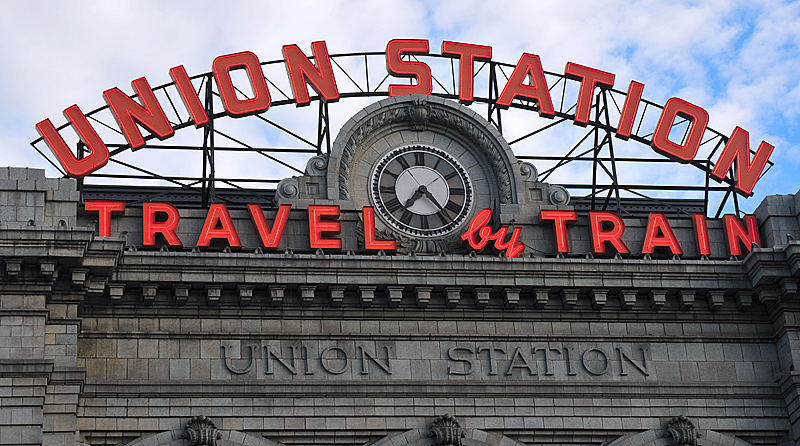






In the Nineteenth Century, San Francisco's grandest mansions were built on top of what is now known as Nob Hill. But they were all doomed; no one anticipated the disastrous earthquake and fire that struck the city early in the morning of April 18, 1906.
Valarie Huff, founder of Hobnob Tours, greeted each of our small tour group as we gathered outside the entrance of the grand, old, Beaux Arts, Fairmont Hotel. Inside, we found seats in the plush, colonnaded lobby while Valarie told us of the nabobs for whom Nob Hill was named, and the luxurious palaces they built.

In the lobby of the Fairmont Hotel, Valarie Huff explains how Nob Hill got its name.
On leaving the Fairmont, we could see, just across Mason Street, the 42 room brownstone mansion of James C. Flood who made his fortune in Nevada’s Comstock mines. Sandstone for the house was quarried and cut in New Jersey and shipped around Cape Horn to San Francisco. Only the Flood mansion and the unfinished Fairmont survived although both buildings were completely gutted.

Huntington Park and the James C. Flood mansion. This was the only mansion on Nob Hill to survive the earthquake although it was badly gutted by the subsequent fire.
Valarie led us west on California Street, past the Flood mansion, to Huntington Park. There we sat by a fountain while she told us of the mansion that once occupied the site. Originally built by David Colton, a Central Pacific Railroad attorney, the massive, white, wooden structure was eventually acquired by one of Central Pacific’s “Big Four”, the real brains behind the railroad empire, Collis P. Huntington. Huntington, who spent most of his time in the east, had at first disapproved when his partners built ostentatious palaces at a time when public criticism of their wealth and business tactics was reaching a feverous pitch. Mrs. Huntington still lived there at the time of the earthquake. She donated the land to the city as a park for all the people to enjoy.

The Associates (California’s Big Four): Collis Potter Huntington (October 22, 1821 – August 13, 1900),, Amasa Leland Stanford (March 9, 1824 – June 21, 1893), Charles Crocker (September 16, 1822 – August 14, 1888) and Mark Hopkins (September 1, 1813 – March 29, 1878). Public domain photos from Wikipedia.
In his book, "The Big Four", Oscar Lewis, commented that, "Crocker's egotism grew with his years and weight, and business associates found him increasingly gruff in manner, dogmatic in upholding his views, and intolerant of opposition".
The only house on the block that Crocker wanted for his new mansion was owned by Nicholas Yong, a stubborn German undertaker. He refused Crocker’s every offer. A contemporary photograph clearly shows what happened next: Crocker ordered a rude board fence built around his neighbor’s house. The fence, forty feet high, enclosed the building on three sides, plunging the family home into perpetual gloom. Only the chimney tops of the unfortunate Young’s house can be seen.
Of course, the hapless Young eventually gave in. His house and the fence were removed, and Crocker could call the whole block his own. His mansion stood complete with a four story tower from which the view of San Francisco and the bay must have been grand.
After the fire, the property was donated by the family. On the spot now stands the French Gothic style Grace Cathedral. It is known for its main doors cast from original molds for the Gates of Paradise in Florence and for its labyrinths, stained glass, carillon, organs, and choir. Valarie stood by as we leisurely explored the interior wonders of this third largest Episcopal cathedral in the United States.
Backtracking along California Street, we walked to the Big Four Restaurant. Inside, on rich, wood paneled walls, is a fine collection of historic photographs of Nob Hill and the nabobs who lived there.
Continuing east on California Street we visited the Mark Hopkins and, finally, the Stanford Court Hotels. The land where these two noteworthy hostelries stand was the first property acquired by the nabobs. Leland Stanford, figurehead president of the Central Pacific Railroad and former governor of California, bought the land along California Street on the then treeless, wind-swept and hopelessly steep slope. Not coincidentally, Stanford was a major financier of the California Street Cable Railway. Thanks to Andrew Hallidie’s new cable cars, Nob Hill was about to become a popular place to build. The cable cars easily traveled up steep hills that were a real effort for a horse with a wagon or a carriage. Stanford shared his whole block purchase with another of the four, Mark Hopkins, treasurer for the partners.

California Street Cable Railway cars still ascend San Francisco’s Nob Hill.
Actually, Mary Hopkins was the chief instigator and planer of their ornate, forty room mansion complete with torrents and towers; Mr. Hopkins was a quiet, reserved man, not given to ostentation. Reluctantly, he indulged his wife. He never had to live in the highly elaborate wooden structure though; he died in 1878 before the house was finished.
In lobby of the Stanford Court, beneath the trademark Tiffany glass dome, we said our goodbyes entertained, educated and even exercised.
If you go
Valarie Huff is founder of Hobnob Tours of San Francisco. She graduated from Berkeley with a major in American History. She was a Senior Docent at San Francisco City Hall. She is currently a docent at Ravenswood House Museum in Livermore, a Director of the San Francisco Opera Guild and an Advisor to the Livermore Valley Opera and a member of the San Francisco Museum & Historical Society.
In addition to the Nob HIll tour, Hobnob offers tours of Union Square/Chinatown and the Financial District.
Website: http://www.hobnobtours.com
E-mail: valtour@comcast.net
Telephone: (650) 814-6303